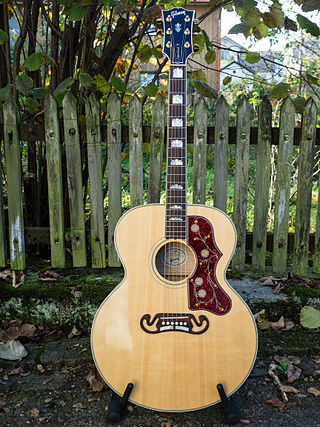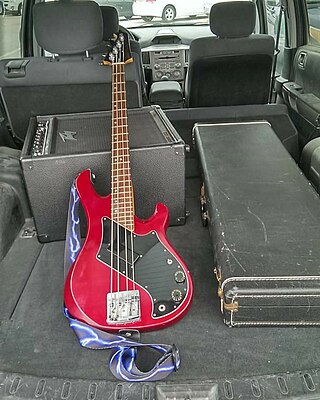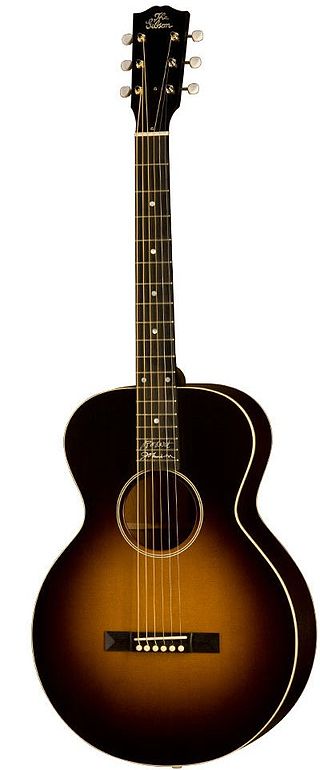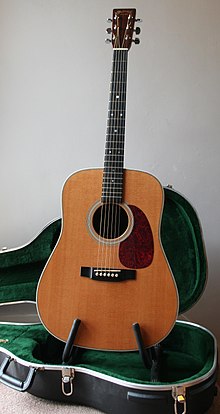
The steel-string acoustic guitar is a modern form of guitar that descends from the gut-strung Romantic guitar, but is strung with steel strings for a brighter, louder sound. Like the modern classical guitar, it is often referred to simply as an acoustic guitar, or sometimes as a folk guitar.

The guitar is a stringed musical instrument that is usually fretted and typically has six or twelve strings. It is usually held flat against the player's body and played by strumming or plucking the strings with the dominant hand, while simultaneously pressing selected strings against frets with the fingers of the opposite hand. A guitar pick may also be used to strike the strings. The sound of the guitar is projected either acoustically, by means of a resonant hollow chamber on the guitar, or amplified by an electronic pickup and an amplifier.

C.F. Martin & Company is an American guitar manufacturer established in 1833 by Christian Frederick Martin. It is highly respected for its acoustic guitars and is a leading manufacturer of flat top guitars and ukuleles. The company has also made mandolins and tiples, as well as several models of electric guitars and electric basses, although none of these other instruments are still in production.
Washburn Guitars is an American brand and importer of guitars, mandolins, and other string instruments, originally established in 1883 in Chicago, Illinois. The Washburn name is controlled by U.S. Music Corp., a subsidiary of Canadian corporate group Exertis|JAM.

The Gibson Hummingbird is an acoustic guitar model/series produced by the Gibson Guitar Corporation.

The Gibson J-160E is one of the first acoustic-electric guitars produced by the Gibson Guitar Corporation.
The Guild Guitar Company is a United States-based guitar manufacturer founded in 1952 by Alfred Dronge, a guitarist and music-store owner, and George Mann, a former executive with the Epiphone Guitar Company. The brand name currently exists as a brand under Córdoba Music Group. In February 2023, The Yamaha Guitar Group acquired Cordoba Music Group.

The Gibson J-45 is a guitar manufactured by the Gibson Guitar Corporation. Generally regarded as Gibson's most famous and widely used acoustic guitar model, it is considered the workhorse of guitars. The Jumbo guitar is signified by the "J" and not to be confused with C.F. Martin & Company's Dreadnought body style. In 1934 the jumbo was Gibson's competing response to Martin's "D" line body shape of 1930s. The jumbo is distinctive from Martin's dreadnoughts: The Gibson J-45 body depth remains over 4″ deep from endpin to neck heel, it also features a slightly larger body than a Martin D-28 as well as the shape of the two competing body styles being quite different; Squarish upper bouts on the Martins opposed to a rounded or “sloped shoulder” on The Gibson. While Martin did produce the first sloped shoulder guitar the specs of the J-45 are dissimilar.
Tacoma Guitars was an American manufacturing company of musical instruments. It was founded in 1991 as a division of South Korean company Young Chang. Instruments were manufactured in Tacoma, Washington. The company and brand name were later acquired by the Fender Musical Instruments Corporation. The Tacoma plant closed, and production ceased, in 2008.

Sigma Guitars is a guitar manufacturing brand originally released by C.F. Martin as a line of guitars at affordable prices to compete with the increasing number of imported guitars from Japan and elsewhere. The Sigma line was discontinued by Martin in 2007. The rights to the name were acquired by German company AMI Musical Instruments GmbH, which relaunched the brand with guitars being produced in China.
The Gibson Advanced Jumbo was an acoustic flattop guitar made by the Gibson Guitar Corporation. Introduced in 1936, is still considered a classic. Only 300 guitars were produced before Gibson replaced it with the Gibson J-200 Super Jumbo, but these guitars are still prized by collectors and musicians today.
George Gruhn is an American writer, businessman and ophiophilist. He is one of the foremost experts on vintage American guitars and fretted instruments, and the author of several books on the subject. He is the founder of Gruhn Guitars in Nashville, and has sold guitars to musicians such as Hank Williams, Jr., Eric Clapton, Brad Paisley, Lyle Lovett, Emmylou Harris, Billy Gibbons, Rick Nielsen, Vince Gill, and John Hiatt.
Guitar bracing refers to the system of wooden struts which internally support and reinforce the soundboard and back of acoustic guitars.

Collings Guitars is an Austin, Texas–based stringed instrument manufacturer. The company was founded in 1973 by BillCollings. In addition to acoustic guitars, Collings Guitars manufactures electric guitars, archtop guitars, mandolins and ukuleles.

The Martin D-45 is a steel-string acoustic guitar model made by C. F. Martin & Company. The model was manufactured from 1933 to 1942, and in a second production series since 1968. Martin originally made the guitar's sides and backs of Brazilian rosewood. Martins are ranked among the highest-quality, as well as among the most expensive guitars, and the D-45, regarded as one of the first "luxury guitars", was listed in 2011 as the most valuable production-model guitar.

The Martin D-28 is a dreadnought-style acoustic guitar made by C. F. Martin & Company of Nazareth, Pennsylvania.

The Gibson Victory Bass was an electric bass guitar produced by Gibson Guitars from 1981 until 1986. It was a bass guitar variant of the Gibson Victory. It was not a successful model.

The Gibson L series is a series of small-body guitars produced and sold by Gibson Guitar Corporation in the early 20th century. The first guitars of this series, Gibson L-0 and Gibson L-1, were introduced first as arch-tops (1902), and later as flat tops in 1926. The L series was later gradually replaced by the LG series in the 1940s.
The Gibson Country Western is a flat-top acoustic guitar model originally manufactured by the Gibson Guitar Corporation between 1956 and 1978. For the first 6(7) years of its manufacture it was a round-shouldered instrument, which changed to square-shouldered in 1962. Sheryl Crow preferred the 1962 model, and uses a modern version of her 1962 instrument released under her name.

The Gibson Southern Jumbo is a flat-top acoustic guitar model originally manufactured by the Gibson Guitar Corporation between 1942 and 1978. For the first 20 years of its manufacture it was a round-shouldered instrument, which changed to square-shouldered in 1962. Several modern reissues have been created by Gibson, based on the round-shouldered version.















